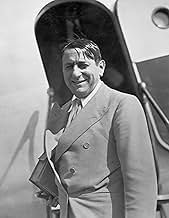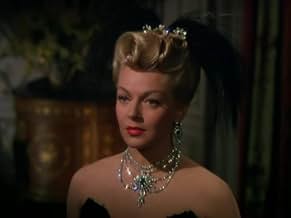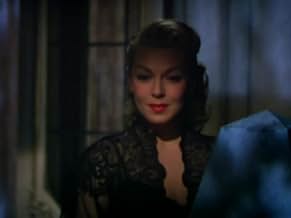NOTE IMDb
5,7/10
701
MA NOTE
Opérant sous des ordres royaux, un comte doit courtiser une jeune et riche veuve afin de sauver un royaume de la faillite.Opérant sous des ordres royaux, un comte doit courtiser une jeune et riche veuve afin de sauver un royaume de la faillite.Opérant sous des ordres royaux, un comte doit courtiser une jeune et riche veuve afin de sauver un royaume de la faillite.
- Réalisation
- Scénario
- Casting principal
- Nommé pour 2 Oscars
- 2 nominations au total
Sujata Rubener
- Gypsy Girl
- (as Sujata)
Ludwig Stössel
- Major Domo
- (as Ludwig Stossel)
John Alban
- Club Patron
- (non crédité)
Erville Alderson
- Cart Driver
- (non crédité)
Bette Arlen
- Girl at Maxim's
- (non crédité)
Frank Arnold
- Waiter
- (non crédité)
Gertrude Astor
- Reception Guest
- (non crédité)
Avis à la une
The lovely Lana Turner stars in this rather lackluster Technicolor musical. In my opinion it is far inferior to the charming and hilarious 1934 Ernst Lubitsch version. (Both films are adaptations of an operetta, so the 1934 one isn't exactly the "original".)
To this film's credit, it's rather different from Lubitsch's version. It doesn't try to be an exact copy and can therefore be judged on its own merits. (I can't say which version of the story is most true to the original play.) This 1952 version is, for one thing, in color and features some new ballads to go with a couple familiar tunes from the earlier film. The songs, however, are largely forgettable. The storyline, about a small European kingdom sending a man to woo a wealthy widow, is a little different in this version, although the general arc is similar. (Viewers familiar with the 1934 version will notice the differences; I won't mention them here.)
This film overall did not impress me, partly because I'd been previously spoiled with the Lubitsch version, which is simultaneously a fairy tale romance and a hilarious comedy (with music, too!). This 1952 version is more of a second-tier MGM romance musical. It's really not a legitimate comedy, although it does try to be funny. But Lana Turner looks great in this good girl role (she'd played many a femme fatale) and the cast isn't bad. I can't fault the movie for trying, but it just falls a little flat for me.
THE MERRY WIDOW (1952) may be fun for musical junkies or viewers who don't know what they're missing, but I'd recommend the comedy of the 1934 version of the same story.
5.5/10
To this film's credit, it's rather different from Lubitsch's version. It doesn't try to be an exact copy and can therefore be judged on its own merits. (I can't say which version of the story is most true to the original play.) This 1952 version is, for one thing, in color and features some new ballads to go with a couple familiar tunes from the earlier film. The songs, however, are largely forgettable. The storyline, about a small European kingdom sending a man to woo a wealthy widow, is a little different in this version, although the general arc is similar. (Viewers familiar with the 1934 version will notice the differences; I won't mention them here.)
This film overall did not impress me, partly because I'd been previously spoiled with the Lubitsch version, which is simultaneously a fairy tale romance and a hilarious comedy (with music, too!). This 1952 version is more of a second-tier MGM romance musical. It's really not a legitimate comedy, although it does try to be funny. But Lana Turner looks great in this good girl role (she'd played many a femme fatale) and the cast isn't bad. I can't fault the movie for trying, but it just falls a little flat for me.
THE MERRY WIDOW (1952) may be fun for musical junkies or viewers who don't know what they're missing, but I'd recommend the comedy of the 1934 version of the same story.
5.5/10
Merry Widow, The (1952)
** (out of 4)
MGM's third attempt at the famous operetta by Franz Lehar probably has the biggest budget but it's lacking quite a bit from the much better 1925 and 1934 versions. This time out a wealthy widow (Lana Turner) is brought to a small country where the government there hopes she will spend her time and money. They hire the good looking Count Danilo (Fernando Lamas) to try and win her over. There's quite a bit to admire in this film but in the end it really left me bored, unattached and rather disappointed. It's very clear from the opening shot that MGM gave director Bernhardt a pretty big budget as the Technicolor really jumps off the screen as does the art direction and set design. Everything visually is striking here as the color really adds an entire dimension to the film and it really helps put you in this era and time. The sets are also quite lavish as we get some really amazing looking ballrooms and other settings that almost make this film worth watching. The costumes are another major plus as it really does seem like it took weeks just to place the extras in order so that the colors of their costumes would just bleed together and be perfectly captured by the cameras. If you just want some great looking eye candy then this film is a must see but the rest of the movie left me wanting a lot more. For starters, I found both Turner and Lamas to be very bland and boring in their roles and I didn't feel a single spark between them. I know Turner was going through some major issues at this point of her life so perhaps this took something away from her but I didn't find anything she did here to be very entertaining. Lamas certainly had the right look for the role but I never really cared for anything he was saying or doing. Una Merkel, a member of the 1934 version, has a few good moments here but not enough to save the film.
** (out of 4)
MGM's third attempt at the famous operetta by Franz Lehar probably has the biggest budget but it's lacking quite a bit from the much better 1925 and 1934 versions. This time out a wealthy widow (Lana Turner) is brought to a small country where the government there hopes she will spend her time and money. They hire the good looking Count Danilo (Fernando Lamas) to try and win her over. There's quite a bit to admire in this film but in the end it really left me bored, unattached and rather disappointed. It's very clear from the opening shot that MGM gave director Bernhardt a pretty big budget as the Technicolor really jumps off the screen as does the art direction and set design. Everything visually is striking here as the color really adds an entire dimension to the film and it really helps put you in this era and time. The sets are also quite lavish as we get some really amazing looking ballrooms and other settings that almost make this film worth watching. The costumes are another major plus as it really does seem like it took weeks just to place the extras in order so that the colors of their costumes would just bleed together and be perfectly captured by the cameras. If you just want some great looking eye candy then this film is a must see but the rest of the movie left me wanting a lot more. For starters, I found both Turner and Lamas to be very bland and boring in their roles and I didn't feel a single spark between them. I know Turner was going through some major issues at this point of her life so perhaps this took something away from her but I didn't find anything she did here to be very entertaining. Lamas certainly had the right look for the role but I never really cared for anything he was saying or doing. Una Merkel, a member of the 1934 version, has a few good moments here but not enough to save the film.
In Australia we are still able to see the beautiful MGM musical in a real 1952 vintage 3 strip Technicolor print which is still in very good condition. I saw it last year and apart from a few bumpy reel changes it is very clean and not scratched too much. Lucky us! I know this is not the definitive version purists rave about (that is the 1934 version) but MGM in 1952 was about as technically lush and state of the art perfect as one could want for any musical. In fact MW is is as colorful and as visually lavish as MY FAIR LADY or ON A CLEAR DAY or HALF A SIXPENCE or even the indoor scenes in TITANIC to any modern audience. The Gen x-ers who saw this version were absolutely in awe of how spectacular this REAL Technicolor version is. Lana is amazingly beautiful and Fernando is his virile Latin he man best. The Waltz in the last reel is exquisite. The only irritating bit is the same 'mid-west-Yanks-in-Europe' antics that annoy in LOVELY TO LOOK AT made the same year. However, who really cares when THE MERRY WIDOW is visually astonishing and musically delicious. What a year it was at MGM in 1952! And this much guarded and treasured proper Hollywood 3 strip Technicolor print is staying here, folks! If you wanna see it you have to come visit.
This 1952 MGM production of Franz Lehar's classic pales in comparison with the Erns Lubitsch's lavish version, that even in black and white, is richer and more appealing to the eye than the later account.
Part of the blame must go to whoever decided to tailor make the film to suit its star, Lana Turner, and the direction of Curtis Bernhardt. As an operetta "The Merry Widow" has been delighting audiences for quite some time. The music alone is worth the price of admission, or in this case, the price of being able to get TCM on cable.
The other interesting thing is how the Technicolor used in the filming of this remake has faded after more than fifty years. The copy shown by TCM recently had a faded look that made it less interesting to watch.
Lana Turner and Fernando Lamas made an attractive couple, but their chemistry doesn't quite make it. Veterans Una Merkel, Thomas Gomez, Richard Haydn, and Marcel Dalio, among others, try their best, but their efforts don't make the film better.
We would strongly advise discerning viewers to check out the older Lubitsch's take on this timeless work.
Part of the blame must go to whoever decided to tailor make the film to suit its star, Lana Turner, and the direction of Curtis Bernhardt. As an operetta "The Merry Widow" has been delighting audiences for quite some time. The music alone is worth the price of admission, or in this case, the price of being able to get TCM on cable.
The other interesting thing is how the Technicolor used in the filming of this remake has faded after more than fifty years. The copy shown by TCM recently had a faded look that made it less interesting to watch.
Lana Turner and Fernando Lamas made an attractive couple, but their chemistry doesn't quite make it. Veterans Una Merkel, Thomas Gomez, Richard Haydn, and Marcel Dalio, among others, try their best, but their efforts don't make the film better.
We would strongly advise discerning viewers to check out the older Lubitsch's take on this timeless work.
This 1952 version of "The Merry Widow" couldn't possibly compare to the 1934 Lubitsch production, but MGM went all out to make a lavish, colorful film starring Lana Turner and Fernando Lamas. To do so, all of the singing, except for one short section, was taken away from Turner. I guess someone thought a soprano voice coming out of her mouth would seem funny to 1952 audiences, which seems a strange decision. Some stars, like Ava Gardner, were dubbed constantly. Lamas did his own singing in a tremulous tenor. Considering the fact that "The Merry Widow" has been a staple of opera companies for years, it really needs some bigger guns. MGM had them but didn't use them.
"The Merry Widow" is about Crystal Radek (Turner), a wealthy widow living, in this version, in New York, whose husband was from a small country, Marshkovia. She is lured to Marshovia under false pretenses. The country is broke and Count Danilo (Lamas) has been asked to court and marry her so the debts can be paid. Danilo mistakes Crystal's attractive but older friend (Una Merkel) for Crystal and is reluctant to pursue her. Crystal finds out why she has been brought to Marshovia and takes off for Paris. Danilo follows her - still not knowing what she looks like - and she follows him to Maxim's and introduces herself as Fifi, a chorus girl. Danilo falls in love with Fifi, but his country has ordered him to marry Crystal.
This film was nominated for best art direction and best costumes, and no wonder. "The Merry Widow" is absolutely gorgeous, with the most heavenly costumes and sets. Turner looks fabulous and despite the long gowns, gets to show off her legs. Lamas makes a handsome and charming Danilo. As Billy Crystal would say, he looks mahvelous.
The supporting players - Thomas Gomez, Richard Haydn, Maurice Danilo, King Donovan, are all excellent, and if you think you recognize Gwen Verdon among the dancers at Maxim's, you do.
The best part of the film is the waltz toward the end of the film, which is stunning. Hitchcock aficionados will recognize "The Merry Widow Waltz" from "Shadow of a Doubt" and get an eerie feeling every time they hear it - which in "The Merry Widow" is more than once.
When Dore Schary took over MGM in 1951, he considered Lana Turner, at the age of 30, nothing more than an over-the-hill actress. She proved him wrong. Seeing her in "The Merry Widow" is a good indication that Dore Schary needed stronger glasses.
"The Merry Widow" is about Crystal Radek (Turner), a wealthy widow living, in this version, in New York, whose husband was from a small country, Marshkovia. She is lured to Marshovia under false pretenses. The country is broke and Count Danilo (Lamas) has been asked to court and marry her so the debts can be paid. Danilo mistakes Crystal's attractive but older friend (Una Merkel) for Crystal and is reluctant to pursue her. Crystal finds out why she has been brought to Marshovia and takes off for Paris. Danilo follows her - still not knowing what she looks like - and she follows him to Maxim's and introduces herself as Fifi, a chorus girl. Danilo falls in love with Fifi, but his country has ordered him to marry Crystal.
This film was nominated for best art direction and best costumes, and no wonder. "The Merry Widow" is absolutely gorgeous, with the most heavenly costumes and sets. Turner looks fabulous and despite the long gowns, gets to show off her legs. Lamas makes a handsome and charming Danilo. As Billy Crystal would say, he looks mahvelous.
The supporting players - Thomas Gomez, Richard Haydn, Maurice Danilo, King Donovan, are all excellent, and if you think you recognize Gwen Verdon among the dancers at Maxim's, you do.
The best part of the film is the waltz toward the end of the film, which is stunning. Hitchcock aficionados will recognize "The Merry Widow Waltz" from "Shadow of a Doubt" and get an eerie feeling every time they hear it - which in "The Merry Widow" is more than once.
When Dore Schary took over MGM in 1951, he considered Lana Turner, at the age of 30, nothing more than an over-the-hill actress. She proved him wrong. Seeing her in "The Merry Widow" is a good indication that Dore Schary needed stronger glasses.
Le saviez-vous
- AnecdotesAfter Lana Turner's millionaire husband Bob Topping left her in 1951, she slashed her wrist and had to wear a bracelet during this shoot to cover the scar.
- GaffesThe statement about beginnings of decades and centuries, is absolutely not correct. :-)
- Citations
King of Marshovia: I'm not asking you to fall in love with the woman. Marriage is quite enough.
- ConnexionsFeatured in Hollywood... Hollywood ! (1976)
- Bandes originalesGirls, Girls, Girls
(uncredited)
Music by Franz Lehár
Lyrics by Paul Francis Webster
Sung by Fernando Lamas
Meilleurs choix
Connectez-vous pour évaluer et suivre la liste de favoris afin de recevoir des recommandations personnalisées
- How long is The Merry Widow?Alimenté par Alexa
Détails
Box-office
- Montant brut aux États-Unis et au Canada
- 4 865 760 $US
- Montant brut mondial
- 9 810 000 $US
- Durée1 heure 45 minutes
- Rapport de forme
- 1.37 : 1
Contribuer à cette page
Suggérer une modification ou ajouter du contenu manquant



































